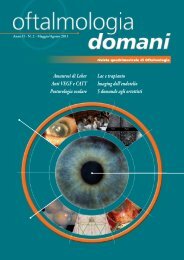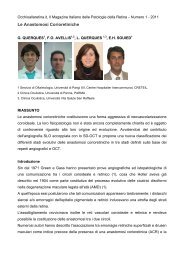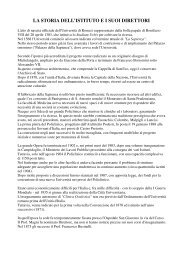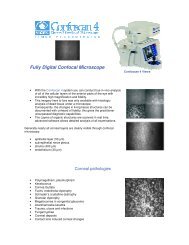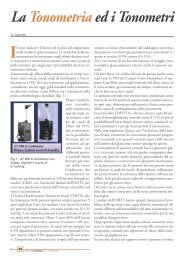(Microsoft PowerPoint - Cosenza DEF 25-03-06 ... - Amedeolucente.it
(Microsoft PowerPoint - Cosenza DEF 25-03-06 ... - Amedeolucente.it
(Microsoft PowerPoint - Cosenza DEF 25-03-06 ... - Amedeolucente.it
Create successful ePaper yourself
Turn your PDF publications into a flip-book with our unique Google optimized e-Paper software.
Lo spessore corneale come indice di<br />
valutazione del tono oculare.<br />
Amedeo Lucente<br />
La Gestione del Glaucoma – <strong>Cosenza</strong> <strong>25</strong>-/<strong>03</strong>/<strong>06</strong>
Il “The Ocular Hypertension Treatment Study”<br />
(OHTS) ha individuato come parametri pred<strong>it</strong>tivi<br />
dell’insorgenza di glaucoma, il rapporto Cup/Disk<br />
verticale ed orizzontale, l’età, la “la pattern<br />
standar deviation”(PSD) del perimetro<br />
Humphrey, la pressione oculare e non meno<br />
importante lo spessore dell’area corneale centrale.<br />
La Gestione del Glaucoma - <strong>Cosenza</strong> <strong>25</strong>/<strong>03</strong>/<strong>06</strong>
Studio OHTS<br />
La Gestione del Glaucoma - <strong>Cosenza</strong> <strong>25</strong>/<strong>03</strong>/<strong>06</strong>
Studio OHTS<br />
La Gestione del Glaucoma- <strong>Cosenza</strong> <strong>25</strong>/<strong>03</strong>/<strong>06</strong>
Studio OHTS<br />
La Gestione del Glaucoma - <strong>Cosenza</strong> <strong>25</strong>/<strong>03</strong>/<strong>06</strong>
►Tonometria ad applanazione di Goldmann<br />
(gold standard)<br />
►Tonometria a soffio computerizzata<br />
La Gestione del Glaucoma - <strong>Cosenza</strong> <strong>25</strong>/<strong>03</strong>/<strong>06</strong>
Principi fisici della Tonometria odierna :<br />
Si considera la cornea come un sistema a rigid<strong>it</strong>à<br />
membranale, cioè come una pellicola domopak<br />
(legge di Imbert-Fick).<br />
La Gestione del Glaucoma - <strong>Cosenza</strong> <strong>25</strong>/<strong>03</strong>/<strong>06</strong>
Che cosa è il sistema a rigid<strong>it</strong>à flessionale:<br />
E’il sistema di flessibil<strong>it</strong>à a cui rispondono i corpi<br />
elastici che hanno uno spessore non trascurabile<br />
come la cornea.<br />
La Gestione del Glaucoma – <strong>Cosenza</strong> <strong>25</strong>/<strong>03</strong>/<strong>06</strong>
In fisica le strutture elastiche che hanno uno<br />
spessore rispondono ad un sistema non<br />
membranale, cioè ad un sistema a:<br />
RIGIDITA’ FLESSIONALE<br />
La Gestione del Glaucoma – <strong>Cosenza</strong> <strong>25</strong>/<strong>03</strong>/<strong>06</strong>
Dipartimento di Meccanica Facoltà di Ingegneria Univers<strong>it</strong>à della Calabria - <strong>Cosenza</strong><br />
Esempio di Simulazione<br />
Spessore Cornea C. : 0.580 mm<br />
Spessore Corneale P. : 0.630 mm<br />
Diametro Verticale : 10.6 mm<br />
Diametro Orizzontale : 11.7 mm<br />
Tono Oculare : 24 mmHg<br />
Carico Esterno : 30 mmHg<br />
Modulo E : 0.4 MPa<br />
La Gestione del Glaucoma – <strong>Cosenza</strong> <strong>25</strong>/<strong>03</strong>/<strong>06</strong>
Un sistema a rigid<strong>it</strong>à flessionale risponde con una<br />
resistenza propria alle sollec<strong>it</strong>azioni di forze esterne.<br />
Un trampolino si flette secondo la seguente formula:<br />
S = saetta di flessione; F = forza esterna;<br />
E = modulo elastico proprio della struttura;<br />
l = lunghezza del trampolino;<br />
a = spessore del trampolino;<br />
b = larghezza del trampolino.<br />
La Gestione del Glaucoma – <strong>Cosenza</strong> <strong>25</strong> /<strong>03</strong>/<strong>06</strong>
Naturalmente la cornea non è un trampolino!<br />
La Gestione del Glaucoma – <strong>Cosenza</strong> <strong>25</strong>/<strong>03</strong>/<strong>06</strong>
Ma neanche una pellicola fotografica.<br />
La Gestione del Glaucoma – <strong>Cosenza</strong> <strong>25</strong>/<strong>03</strong>/<strong>06</strong>
►La rigid<strong>it</strong>à della cornea è di tipo flessionale e<br />
presenta una certa resistenza.<br />
►La rigid<strong>it</strong>à corneale dipende fortemente dallo<br />
spessore.<br />
►La cornea è tanto più rigida quanto più è spessa,<br />
con un valore al cubo.<br />
La Gestione del Glaucoma – <strong>Cosenza</strong> <strong>25</strong>/<strong>03</strong>/<strong>06</strong>
Lo spessore quindi è importante.<br />
La Gestione del Glaucoma – <strong>Cosenza</strong> <strong>25</strong>/<strong>03</strong>/<strong>06</strong>
Ma anche la curvatura non deve essere<br />
trascurata, anche se molte sono le difficoltà<br />
che devono essere superate per trovare una<br />
relazione possibile tra la curvatura corneale<br />
e il tono. A par<strong>it</strong>à di spessore, una maggiore<br />
o minore curvatura corneale è un elemento<br />
da valutare per l’influenza che può avere<br />
sulla flessibil<strong>it</strong>à della cornea stessa.<br />
La Gestione del Glaucoma – <strong>Cosenza</strong> <strong>25</strong>/<strong>03</strong>/<strong>06</strong>
La curvatura e la morfologia corneale sono importanti.<br />
La Gestione del Glaucoma – <strong>Cosenza</strong> <strong>25</strong>/<strong>03</strong>/<strong>06</strong>
I tonometri attualmente in uso non tengono conto né<br />
della curvatura né dello spessore della cornea.<br />
Ma allora cosa realmente misuriamo con la tonometria<br />
ad applanazione e/o a soffio?<br />
La Gestione del Glaucoma – <strong>Cosenza</strong> <strong>25</strong>/<strong>03</strong>/<strong>06</strong>
Misuriamo la tensione endoculare dovuta alla quant<strong>it</strong>à di<br />
acqueo in camera anteriore, la resistenza della cornea, o<br />
entrambi questi dati sommati in un unico risultato finale?<br />
Sicuramente la cornea partecipa in qualche modo<br />
a determinare il tono oculare con il suo modulo<br />
elastico (di Young); modulo elastico che dipende<br />
dalla sua struttura biologica, dal suo spessore e<br />
dalla sua curvatura.<br />
La Gestione del Glaucoma – <strong>Cosenza</strong> <strong>25</strong>/<strong>03</strong>/<strong>06</strong>
Quanto lo spessore corneale influenza il valore<br />
rilevato dai tonometri in uso?<br />
Ehlers già nel 1975 propose un abaco di correzione<br />
dei valori pressori compresi tra 10 e 30 mmHg per<br />
cornee di spessore tra 450 e 590 micron.<br />
La Gestione del Glaucoma – <strong>Cosenza</strong> <strong>25</strong>/<strong>03</strong>/<strong>06</strong>
Tabella-Abaco di Ehlers:<br />
T 10 15 20 <strong>25</strong> 30<br />
0,450 4,2 4,7 5,2 5,7 6,2<br />
0,460 3,5 4,0 4,4 4,8 5,3<br />
0,470 2,9 3,3 3,7 3,0 4,5<br />
0,480 2,2 2,6 2,9 3,3 3,6<br />
0,490 1,5 1,8 2,2 2,5 2,8<br />
0,500 0,9 1,2 1,4 1,7 1,9<br />
0,510 0,3 0,5 0,7 0,9 1,1<br />
0,520 -0,4 -0,2 0,0 0,1 0,3<br />
0,530 -1,0 -0,8 -0,7 -0,6 -0,5<br />
0,540 -1,6 -1,5 -1,4 -1,3 -1,2<br />
0,550 -2,2 -2,1 -2,1 -2,0 -2,0<br />
0,560 -2,8 -2,8 -2,8 -2,8 -2,7<br />
0,570 -3,4 -3,4 -3,4 -3,4 -3,4<br />
0,580 -3,9 -4,0 -4,1 -4,1 -4,2<br />
0,590 -4,5 -4,6 -4,7 -4,8 -4,9<br />
La Gestione del Glaucoma – <strong>Cosenza</strong> <strong>25</strong>/<strong>03</strong>/<strong>06</strong>
Altri studi, (Whintacre 1993, Doughty 2000, Feltgen<br />
2001), minimizzano l’importanza dello spessore<br />
corneale. In pratica si va da correzioni di 0,7 mmHg a<br />
0,2 mmHg ogni 10 micron di variazione in più o in<br />
meno rispetto al valore standard pachimetrico, che<br />
nella mia casistica è di 554 micron.<br />
La Gestione del Glaucoma – <strong>Cosenza</strong> <strong>25</strong>/<strong>03</strong>/<strong>06</strong>
514 Pazienti per valore di Tono misurato<br />
55<br />
51 52 49 48<br />
34<br />
50<br />
45<br />
40<br />
39<br />
44<br />
48<br />
Pazienti<br />
35<br />
30<br />
<strong>25</strong><br />
20<br />
15<br />
10<br />
5<br />
0<br />
29<br />
21 22<br />
19<br />
14 14<br />
9<br />
7<br />
4<br />
2 3<br />
1<br />
2<br />
1 1<br />
6 7 8 9 10 11 12 13 14 15 16 17 18 19 20 21 22 23 24 26 27 29 30<br />
Tono (mm Hg)<br />
La Gestione del Glaucoma – <strong>Cosenza</strong> <strong>25</strong>/<strong>03</strong>/<strong>06</strong>
514 Pazienti per valore pachimetrico<br />
55<br />
54<br />
50<br />
45<br />
40<br />
Pazienti<br />
35<br />
30<br />
<strong>25</strong><br />
20<br />
15<br />
28<br />
21<br />
17<br />
26<br />
28<br />
31<br />
16<br />
30<br />
15<br />
13<br />
26<br />
12<br />
32<br />
17<br />
24<br />
20<br />
14<br />
10<br />
5<br />
0<br />
430<br />
1 1<br />
4<br />
470<br />
2<br />
4<br />
480<br />
6<br />
8<br />
490<br />
5<br />
9<br />
500<br />
7<br />
510<br />
520<br />
Pachimetria media =554 µm<br />
Età da 5 a 88; media 40aa<br />
Tono medio 16 mmHg<br />
5<br />
530<br />
9<br />
8<br />
6<br />
4<br />
2 1 2 1 1 1 2 1<br />
540<br />
550<br />
560<br />
570<br />
580<br />
590<br />
600<br />
610<br />
620<br />
630<br />
640<br />
660<br />
680<br />
Pachimetria µm<br />
La Gestione del Glaucoma – <strong>Cosenza</strong> <strong>25</strong>/<strong>03</strong>/<strong>06</strong>
Valori a confronto per differenza di età<br />
Pazienti<br />
Età < di anni 30 Età > di anni 30<br />
216 298<br />
Medio 569 536<br />
Paki<br />
Minimo<br />
470<br />
470 430<br />
Massimo 680 615<br />
Medio 17 17<br />
Tono<br />
Minimo 6 7<br />
Massimo 30 29<br />
La Gestione del Glaucoma – <strong>Cosenza</strong> <strong>25</strong>/<strong>03</strong>/<strong>06</strong>
50<br />
45<br />
40<br />
194 pazienti con tono superiore ≥18 mmHg (dai 514)<br />
48<br />
44<br />
39<br />
35<br />
30<br />
Pazienti<br />
<strong>25</strong><br />
20<br />
21<br />
22<br />
15<br />
10<br />
5<br />
0<br />
9<br />
3<br />
4<br />
2<br />
1 1<br />
18 19 20 21 22 23 24 26 27 29 30<br />
Tono (mmHg)<br />
La Gestione del Glaucoma – <strong>Cosenza</strong> <strong>25</strong>/<strong>03</strong>/<strong>06</strong>
Paki su 194 pazienti con tono ≥ 18 mmHg (dai 514)<br />
20<br />
19<br />
20<br />
18<br />
17<br />
16<br />
14<br />
12<br />
11<br />
12<br />
Pazienti<br />
10<br />
8<br />
6<br />
4<br />
2<br />
1 1<br />
2<br />
3<br />
6<br />
5<br />
2<br />
4<br />
9<br />
8<br />
2<br />
6<br />
7 7<br />
8<br />
10<br />
5 5<br />
6<br />
4<br />
2<br />
1 1<br />
2<br />
1<br />
4<br />
1 1 1<br />
0<br />
485 495 515 5<strong>25</strong> 535 545 555 565 575 585 595 605 615 6<strong>25</strong> 635 650 670<br />
Pachimetria media = 574 µm<br />
Età da 5 a 82aa media = 38aa<br />
75% ≥ 550 µm; tono medio 20 mmHg<br />
Pachimetria µm<br />
La Gestione del Glaucoma – <strong>Cosenza</strong> <strong>25</strong>/<strong>03</strong>/<strong>06</strong>
204 pazienti con tono ≤ a 12 mmHg (nuovo gruppo)<br />
60<br />
56<br />
57<br />
50<br />
44<br />
Pazienti<br />
40<br />
30<br />
27<br />
20<br />
17<br />
10<br />
3<br />
0<br />
6 8 9 10 11 12<br />
Tono mmHg<br />
La Gestione del Glaucoma – <strong>Cosenza</strong> <strong>25</strong>/<strong>03</strong>/<strong>06</strong>
204 pazienti con tono ≤ a 12 mmHg (nuovo gruppo)<br />
<strong>25</strong><br />
21<br />
22<br />
20<br />
18<br />
Pazienti<br />
15<br />
10<br />
5<br />
1 1 1<br />
3<br />
6<br />
4<br />
6<br />
5<br />
10<br />
14<br />
13<br />
8<br />
6<br />
11<br />
9 9<br />
5<br />
7<br />
5<br />
8<br />
2<br />
1<br />
4<br />
2<br />
1 1<br />
0<br />
430<br />
440<br />
455<br />
460<br />
470<br />
475<br />
480<br />
485<br />
490<br />
495<br />
500<br />
505<br />
510<br />
515<br />
520<br />
5<strong>25</strong><br />
530<br />
535<br />
540<br />
545<br />
550<br />
555<br />
560<br />
565<br />
570<br />
575<br />
580<br />
585<br />
590<br />
Pachimetria µm<br />
Pachimetria media = 516 µm<br />
Età da 5 a 86aa media = 40aa<br />
15%≥ 550 µm; tono medio 10 mmHg<br />
La Gestione del Glaucoma – <strong>Cosenza</strong> <strong>25</strong>/<strong>03</strong>/<strong>06</strong>
Metodo dei minimi quadrati – Facoltà di Statistica - Univers<strong>it</strong>à della Calabria – <strong>Cosenza</strong><br />
ANOVA (analysis of variance)<br />
30<br />
Dipendenza Tono-Spessore<br />
<strong>25</strong><br />
20<br />
Tono mmHg<br />
15<br />
10<br />
5<br />
0<br />
400 450 500 550 600 650 700<br />
Spessore Corneale µm<br />
Tono = -14,63 + 0,056 Paki ; (tono = a + b Paki + e)<br />
± 0,56 mmHg ogni 10 µm<br />
514 pazienti osservati<br />
La Gestione del Glaucoma – <strong>Cosenza</strong> <strong>25</strong>/<strong>03</strong>/<strong>06</strong><br />
Pachimetria media 554 µm
Considerazioni cliniche<br />
► Prudenza nella valutazione del tono oculare<br />
come valore assoluto e ver<strong>it</strong>iero;<br />
► Necess<strong>it</strong>à di correlarlo alla morfologia della<br />
cornea e del bulbo in esame (spessore e curvatura<br />
sicuramente, ma forse anche opac<strong>it</strong>à stromali,<br />
diametro bianco-bianco, profond<strong>it</strong>à della camera<br />
anteriore, presenza di cataratta dura e/o<br />
intumescente, lunghezza assiale del bulbo).<br />
La Gestione dl Glaucoma – <strong>Cosenza</strong> <strong>25</strong>/<strong>03</strong>/<strong>06</strong>
20mmHg di tono oculare non può avere lo stesso<br />
significato se rilevato con 650 micron di spessore o<br />
con 420 micron. Se facciamo per semplificare una<br />
proporzione, considerando 550 micron come valore<br />
standard, con 650 micron troviamo un valore di 16,9<br />
mmHg e con 420 micron un valore di 26,1 mmHg<br />
(una differenza di 9,2 mmHg tra i due valori estremi).<br />
Non mi sembra cosa trascurabile!<br />
650:20=550:X; X=16,9 420:20=550:X; X=26,1<br />
La Gestione del Glaucoma – <strong>Cosenza</strong> <strong>25</strong>/<strong>03</strong>/<strong>06</strong>
P r a s s i C l i n i c a<br />
►Valutare lo spessore corneale in tutti i pazienti che<br />
devono iniziare terapia anti-ipertensiva e in quelli già<br />
in terapia, iniziando da una valutazione alla lampada a<br />
fessura;<br />
►Valutare la curvatura ed in caso di perpless<strong>it</strong>à per il<br />
profilo corneale eseguire anche un esame topografico<br />
(Kcono);<br />
► Valutare con precisione la diagnosi di ipertensione o<br />
di ipotensione oculare e di glaucoma normotensivo,<br />
senza incorrere in fals<strong>it</strong>à tonometriche.<br />
La Gestione del Glaucoma – <strong>Cosenza</strong> <strong>25</strong>/<strong>03</strong>/<strong>06</strong>
Il fine di questa disamina, senza pretese di alcuna<br />
dogmatic<strong>it</strong>à, sta nella speranza di aver stimolato<br />
l’interesse sul dato più semplice e fondamentale,<br />
troppo spesso preso come ver<strong>it</strong>à assoluta:<br />
il TONO OCULARE.<br />
La Gestione del Glaucoma – <strong>Cosenza</strong> <strong>25</strong>/<strong>03</strong>/<strong>06</strong>
L’ideale sarebbe misurare il tono oculare come<br />
valore integrato ai dati corneali contestualmente<br />
rilevati e corretto con un algor<strong>it</strong>mo che tenga<br />
conto di tutte queste variabili anatomiche corneali<br />
e forse anche bulbari.<br />
La Gestone dl Glaucoma – <strong>Cosenza</strong> <strong>25</strong>/<strong>03</strong>/<strong>06</strong>
La Gestione del Glaucoma – <strong>Cosenza</strong> <strong>25</strong>/<strong>03</strong>/<strong>06</strong>
Parco Nazionale<br />
Del Pollino
Grazie per l’attenzione<br />
La Gestione del Glaucoma – <strong>Cosenza</strong> <strong>25</strong>/<strong>03</strong>/<strong>06</strong>
Confronto per differenza di età dei 204 pazienti con Tono ≤ a 12mmHg<br />
Pazienti<br />
Età < di anni 30 Età > di anni 30<br />
87 117<br />
Medio 517 514<br />
Paki<br />
Minimo 440<br />
440 430<br />
Massimo 586 590<br />
Medio 10 11<br />
Tono<br />
Minimo 6 8<br />
Massimo 12 12<br />
La Gestione del Glaucoma – <strong>Cosenza</strong> <strong>25</strong>/<strong>03</strong>/<strong>06</strong>
Confronto per differenza di età dei 194 pazienti con Tono ≥ a 18mmHg<br />
Pazienti<br />
Età < di anni 30 Età > di anni 30<br />
86 108<br />
Medio 584 567<br />
Paki<br />
Minimo 515<br />
515 485<br />
Massimo 680 615<br />
Medio 20 20<br />
Tono<br />
Minimo 18 18<br />
Massimo 30 29<br />
La Gestione del Glaucoma – <strong>Cosenza</strong> <strong>25</strong>/<strong>03</strong>/<strong>06</strong>


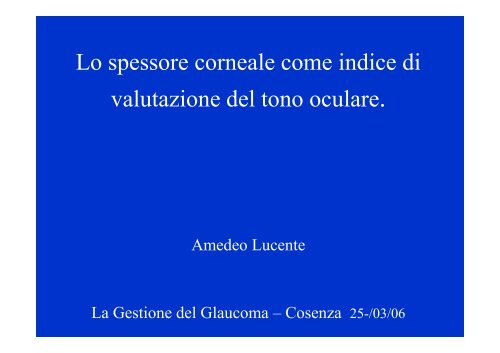
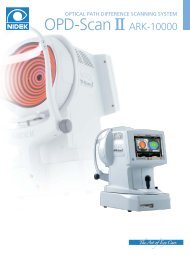





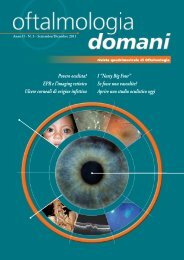

![scarica questo file [PDF, 524 kB] - Gerlos - Altervista](https://img.yumpu.com/48083579/1/190x143/scarica-questo-file-pdf-524-kb-gerlos-altervista.jpg?quality=85)
